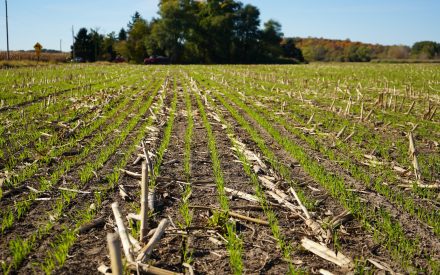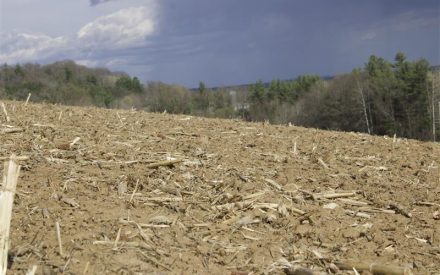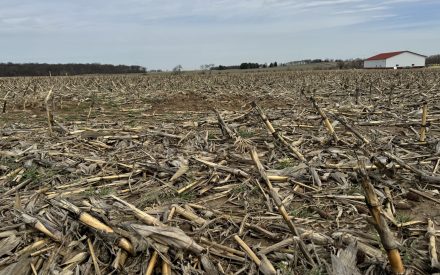Phosphorus is a vital macronutrient for crop production, a major contributor to aquatic degradation, and a finite global resource and thus is important agronomically, environmentally, and economically. Phosphorus loss to water resources happens in every agricultural production system. Fortunately, there are management options that decrease the risk and amount of phosphorus loss to water resources without sacrificing farm profitability. Years of research and monitoring have generated knowledge about multiple in-field and edge-of-field tools to minimize this risk, including erosion control, application timing and placement of phosphorus sources, and the drawdown of soil test phosphorus (STP) through crop and nutrient management.
As water quality knowledge has advanced, so has Wisconsin agriculture’s ingenuity and farm landscape. This publication series elevates the topic of phosphorus management by highlighting the latest research on phosphorus loss as it relates to soil, fertilizer and manure management strategies.
Wisconsin context on phosphorus loss
Phosphorus is not lost to the air or fixed from the air like nitrogen, so it is useful to conceptualize the phosphorus issue in Wisconsin as a budget. The soil in Wisconsin is able to bind phosphorus to its surface and therefore acts as a bank to the environment. The amount held or released by soil is based on soil’s pH, organic matter, and clay content, along with climate conditions that impact soil microbial activity, like temperature, moisture and aeration.
The rich history of animal agriculture and manure application in Wisconsin has led to a positive phosphorus balance, or excess phosphorus held in the soil. Historically, more phosphorus via manure or fertilizer has been added to agricultural land than what is removed with crops. Early nutrient management plans prescribed applying manure to meet crop nitrogen needs, which led to phosphorus application in excess of crop requirements. The drawdown of excess phosphorus from the soil “bank” takes much longer than nitrogen or the breakdown of herbicides in soil. A typical corn crop only removes 3-5 parts per million (ppm) of soil P per year, therefore it takes many years to draw down a significant portion of phosphorus from the soil bank (Laboski et.al, 2006). Meanwhile, that P is vulnerable to be lost to the environment. The pathways for phosphorus removal from a system are loss of soil, loss in runoff, or biomass removal.
The majority of water bodies on Wisconsin’s Impaired Waters List are a result of excess phosphorus. Since agricultural land use composes the majority of many of these watersheds, this is where opportunities lie to make water quality improvements. Of 94 water bodies proposed to be added to the 2022 Impaired Waters list, 56% have total phosphorus as the pollutant, the majority of which originates from agricultural land. Zero phosphorus loss is not a realistic goal as some loss via water movement through runoff is inevitable. However, excess losses lead to water quality problems impacting the environment and the livelihoods of those who depend on quality water.
Advanced phosphorus loss understanding
Phosphorus loss from agriculture requires a source of P and a transport mechanism. Twenty years of UW Discovery Farms edge of field monitoring–as well as other research–has advanced understanding of when and what specific form of phosphorus leaves fields. A high proportion of total phosphorus loss occurs during late winter and early spring, correlating with surface runoff during snowmelt and soil loss during extreme summer rains (Figure 1). A majority of phosphorus loss (>75%) occurs during a six month period. By understanding high risk time periods, and when different sources of P can leave fields, agriculture can have a large impact on reducing total phosphorus loss through the year.
Phosphorus with soil loss
Historically, there has been a perception that phosphorus loss has been associated with soil erosion, and research has shown erosion can still be a significant driver of P loss. A majority of soil loss occurs during May and June in Wisconsin. This is when P is lost in the particulate form. Particulate P is bound to soil particles and thus is lost with soil movement. Reduced tillage and overwintering cover crops help to keep soil in place by promoting soil aggregation and providing residue that protects soil from wind and water during this vulnerable period. The increase in adoption of soil conservation practices has started to address the particulate P loss in the critical months of May, June and July across Wisconsin (Figure 2).
Phosphorus without soil loss
The remaining P lost is in the dissolved form, the portion of P in solution with water. Dissolved P does not need soil movement to be lost. The majority of these losses occur in January, February, and March, during periods of frozen soil and/or snowmelt (Figure 2). Clear runoff does not always mean that no P is leaving the field. When water interacts with organic and water-soluble forms of P, dissolved P can enter runoff. Commonly, one may think of recent manure applications as the source for dissolved P. But it can come from water interacting with any P sources such as fall or winter surface applied fertilizer, residue from the last crop or cover crop, or P in the soil. Intentional or unintentional soil P buildup results in increased risk of dissolved P losses, particularly in systems like no-till or those where nutrients are mainly surface applied and become concentrated at the surface. Since the ground is frozen in the winter, during precipitation events or snow melt, water infiltration is limited or prevented causing dissolved P to leave via runoff. Weather, and therefore runoff leaving the field cannot be controlled, but the amount of phosphorus available to runoff can be.
Common phosphorus sources
- Plant organic material (residue, perennial crop, cover crop, etc).
- Phosphorus is a macronutrient and is taken up in large amounts by plants. As plant matter breaks down, P can be released back into the soil. Residue and high amounts of plant biomass are often concentrated at the surface, leaving it vulnerable to dissolved P loss, as runoff may interact with the decomposing material while leaving the field.
- Manure
- Only a portion of the P eaten by livestock remains in their bodies or milk, the rest leaves in the manure. When manure is applied when no plants are growing, P can be vulnerable to loss, either through interacting with runoff water or by binding to eroding soil. When the P in manure is applied at a greater rate than crop removal, it causes high levels of phosphorus to build over time, creating more risk when a runoff event occurs.
- Synthetic Fertilizer
- Phosphorus formed from minerals, is vital for crop production when manure is not available. However, timing and placement of phosphorus can decrease likelihood of loss and increase use efficiency.
- Soil
- Phosphorus typically binds to clay and other minerals, but is in constant interaction with the soil solution (soil water) where the P is available to the plant. If a soil has high P content and that soil is washed away, so is the P attached.
- Soil test P is an estimate of plant available P, and is only a portion of the total P in soils.
- Because P can be stored in the soil, soil acts as a bank that can hold excess P and release it back into the soil solution to be available to plants, or unfortunately to be lost with water movement.
Phosphorus transport mechanisms
- P absorbed to eroding sediments
- When soil is moved by water, the phosphorus attached to soil organic matter or absorbed to clay particles moves with it. The amount of P lost is based on the amount of P in the soil and the amount of soil lost. Soils with fine textures, high clay content, and high levels of organic matter will typically have more P absorbed to it, and therefore more P lost with sediment movement.
- Dissolved (soluble) P loss in runoff water
- Dissolved P is the amount of P that is mixed in the solution of water, not what is attached to soil particles.
- The amount of dissolved P loss is typically related to the amount and location of each P source. These sources include soil test P, synthetic fertilizer, manure, and plant material (residue, cover crop or crop biomass).
- Although increasing infiltration can decrease the amount of water running off a field, a better approach is to focus on the amount of P source readily available.


 Phosphorus Losses Checked by Layered Practices and Careful Timing: A Discovery Farms Project
Phosphorus Losses Checked by Layered Practices and Careful Timing: A Discovery Farms Project ▶ The Zone of Interaction: Exploring phosphorus stratification
▶ The Zone of Interaction: Exploring phosphorus stratification Wanted: Fields under cover
Wanted: Fields under cover Flood Mitigation and Water Quality in Southwest Wisconsin
Flood Mitigation and Water Quality in Southwest Wisconsin


